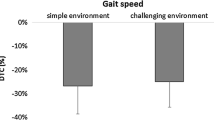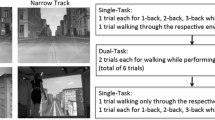Abstract
Walking is generally viewed as an automated, over-learned, rhythmic motor task and may even be considered the lower-limb analog of rhythmic finger tapping, another automated motor task. Thus, one might hypothesize that walking would be associated with a simple rhythmic task like tapping rather than with a complex motor task like catching. Surprisingly, however, we find that among older adults, routine walking has more in common with complex motor tasks, like catching a moving object, than it does with tapping. Tapping performance, including both the average tapping interval and the variability of tapping interval, was not significantly associated with any gait parameter (gait speed, average stride time and stride time variability). In contrast, catch game performance was significantly associated with measures of walking, suggesting that walking is more like catching than it is like tapping. For example, participants with a higher gait speed tended to have lower times to first move when catching, better catching accuracy, and less catching errors. Stride time variability was significantly associated with each of the measures of catching. Participants with a lower stride time variability (a more steady gait) had better catching accuracy, lower time to first move, fewer direction changes when moving the cursor to catch the falling object, and less catching errors. To understand this association, we compared walking performance to performance on the Stroop test, a classic measure of executive function, and tests of memory. Walking was associated with higher-level cognitive resources, specifically, executive function, but not with memory or cognitive function in general. For example, a lower (better) stride time variability was significantly associated with higher (better) scores on the Stroop test, but not with tests of memory. Similarly, when participants were stratified based on their performance on the Stroop test and tests of memory, stride time variability was dependent on the former, but not the latter. These findings underscore the interconnectedness of gait and cognitive function, indicate that even routine walking is a complex cognitive task that is associated with higher-level cognitive function, and suggest an alternative approach to the treatment of gait and fall risk in the elderly.

Similar content being viewed by others
References
AGS (2001) AGS Guidelines: Guideline for the prevention of falls in older persons. American Geriatrics Society, British Geriatrics Society, and American Academy of Orthopaedic Surgeons Panel on Falls Prevention. J Am Geriatr Soc 49:664–672
Bennett DA, Shannon KM, Beckett LA, Wilson RS (1999) Dimensionality of parkinsonian signs in aging and Alzheimer’s disease. J Gerontol A Biol Sci Med Sci 54:M191–M196
Bloem BR, Valkenburg VV, Slabbekoorn M, Gert VD (2001) The multiple tasks test. Strategies in Parkinson’s disease. Exp Brain Res 137:478–486
Brown RG, Marsden CD (1991) Dual task performance and processing resources in normal subjects and patients with Parkinson’s disease. Brain 114(1A):215–231
Burke RE, Degtyarenko AM, Simon ES (2001) Patterns of locomotor drive to motoneurons and last-order interneurons: clues to the structure of the CPG. J Neurophysiol 86:447–462
Camicioli R, Howieson D, Lehman S, Kaye J (1997) Talking while walking: the effect of a dual task in aging and Alzheimer’s disease. Neurology 48:955–958
Cocchini G, Della Sala S, Logie RH, Pagani R, Sacco L, Spinnler H (2004) Dual task effects of walking when talking in Alzheimer’s disease. Rev Neurol (Paris) 160:74–80
Della Sala S, Baddeley A, Papagno C, Spinnler H (1995) Dual-task paradigm: a means to examine the central executive. Ann NY Acad Sci 769:161–171
Dwolatzky T, Whitehead V, Doniger GM et al (2003) Validity of a novel computerized cognitive battery for mild cognitive impairment. BMC Geriatr 3:4
Fahn S, Elton R, Members of the UPDRS Development Committee (1987) Unified Parkinson’s disease rating scale. In: Fahn S, Marsden C, Calne D, Goldstein M (eds) Recent developments in Parkinson’s disease. Florham Park, NJ, USA, pp 153–63
Folstein MF, Folstein SE, McHugh PR (1975) “Mini-mental state”. A practical method for grading the cognitive state of patients for the clinician. J Psychiatr Res 12:189–198
Fukuyama H, Ouchi Y, Matsuzaki S et al (1997) Brain functional activity during gait in normal subjects: a SPECT study. Neurosci Lett 228:183–186
Giladi N, Shabtai H, Gurevich T, Benbunan B, Anca M, Korczyn AD (2003) Rivastigmine (Exelon) for dementia in patients with Parkinson’s disease. Acta Neurol Scand 108:368–373
Gnanalingham KK, Byrne EJ, Thornton A, Sambrook MA, Bannister P (1997) Motor and cognitive function in Lewy body dementia: comparison with Alzheimer’s and Parkinson’s diseases. J Neurol Neurosurg Psychiatry 62:243–252
Goldman WP, Baty JD, Buckles VD, Sahrmann S, Morris JC (1999) Motor dysfunction in mildly demented AD individuals without extrapyramidal signs. Neurology 53:956–962
Guralnik JM, Ferrucci L, Pieper CF et al (2000) Lower extremity function and subsequent disability: consistency across studies, predictive models, and value of gait speed alone compared with the short physical performance battery. J Gerontol A Biol Sci Med Sci 55:M221–M231
Hausdorff JM, Cudkowicz ME, Firtion R, Wei JY, Goldberger AL (1998) Gait variability and basal ganglia disorders: stride-to-stride variations of gait cycle timing in Parkinson’s disease and Huntington’s disease. Mov Disord 13:428–437
Hausdorff JM, Rios D, Edelberg HK (2001) Gait variability and fall risk in community-living older adults: a 1-year prospective study. Arch Phys Med Rehabil 82:1050–1056
Hausdorff JM, Balash J, Giladi N (2003) Effects of cognitive challenge on gait variability in patients with Parkinson’s disease. J Geriatr Psychiatry Neurol 16:53–58
Herman T, Giladi N, Gurevich T, Hausdorff JM (2005) Gait instability and fractal dynamics of older adults with a “cautious” gait: why do certain older adults walk fearfully? Gait Posture 21:178–185
Jylha M, Guralnik JM, Balfour J, Fried LP (2001) Walking difficulty, walking speed, and age as predictors of self-rated health: the women’s health and aging study. J Gerontol A Biol Sci Med Sci 56:M609–M617
Kerrigan DC, Todd MK, Della CU, Lipsitz LA, Collins JJ (1998) Biomechanical gait alterations independent of speed in the healthy elderly: evidence for specific limiting impairments. Arch Phys Med Rehabil 79:317–322
Lamb T, Yang JF (2000) Could different directions of infant stepping be controlled by the same locomotor central pattern generator? J Neurophysiol 83:2814–2824
Langenecker SA, Nielson KA, Rao SM (2004) fMRI of healthy older adults during Stroop interference. Neuroimage 21:192–200
MacLeod CM (1991) Half a century of research on the Stroop effect: an integrative review. Psychol Bull 109:163–203
Maki BE (1997) Gait changes in older adults: predictors of falls or indicators of fear. J Am Geriatr Soc 45:313–320
Marquis S, Moore MM, Howieson DB et al (2002) Independent predictors of cognitive decline in healthy elderly persons. Arch Neurol 59:601–606
McMahon TA (1984) Muscles, reflexes, and locomotion. Princeton University Press, NJ, USA
Montagne G, Laurent M, Durey A, Bootsma R (1999) Movement reversals in ball catching. Exp Brain Res 129:87–92
Nakamura T, Meguro K, Sasaki H (1996) Relationship between falls and stride length variability in senile dementia of the Alzheimer type. Gerontology 42:108–113
Persad CC, Giordani B, Chen HC et al (1995) Neuropsychological predictors of complex obstacle avoidance in healthy older adults. J Gerontol B Psychol Sci Soc Sci 50:272–277
Riecker A, Wildgruber D, Mathiak K, Grodd W, Ackermann H (2003) Parametric analysis of rate-dependent hemodynamic response functions of cortical and subcortical brain structures during auditorily cued finger tapping: a fMRI study. Neuroimage 18:731–739
Schaafsma JD, Giladi N, Balash Y, Bartels AL, Gurevich T, Hausdorff JM (2003) Gait dynamics in Parkinson’s disease: relationship to Parkinsonian features, falls and response to levodopa. J Neurol Sci 212:47–53
Schenk T, Mair B, Zihl J (2004) The use of visual feedback and on-line target information in catching and grasping. Exp Brain Res 154:85–96
Schweiger A, Doniger GM, Dwolatzky T, Jaffe D, Simon ES (2003) Reliability of a novel computerized neuropsychological battery for mild cognitive impairment. Acta Neuropsychologica 1:407–413
Shefchyk SJ, Jordan LM (1985) Excitatory and inhibitory postsynaptic potentials in alpha-motoneurons produced during fictive locomotion by stimulation of the mesencephalic locomotor region. J Neurophysiol 53:1345–1355
Sheridan PL, Solomont J, Kowall N, Hausdorff JM (2003) Influence of executive function on locomotor function: divided attention increases gait variability in Alzheimer’s disease. J Am Geriatr Soc 51:1633–1637
Spreen O, Strauss E (1988) A compendium of neuropsychological tests: administration, norms and commentary. Oxford University Press, NY, USA
Szameitat AJ, Schubert T, Muller K, Von Cramon DY (2002) Localization of executive functions in dual-task performance with FMRI. J Cogn Neurosci 14:1184–1199
Verghese J, Lipton RB, Hall CB, Kuslansky G, Katz MJ, Buschke H (2002) Abnormality of gait as a predictor of non-Alzheimer’s dementia. N Engl J Med 347:1761–1768
Wilson RS, Schneider JA, Beckett LA, Evans DA, Bennett DA (2002) Progression of gait disorder and rigidity and risk of death in older persons. Neurology 58:1815–1819
Woollacott M, Shumway-Cook A (2002) Attention and the control of posture and gait: a review of an emerging area of research. Gait Posture 16:1–14
Acknowledgements
This work was supported in part by grants from the NIA, NICHD and NCRR and by a grant from the Institute for the Study of Aging. We thank Dr. Glen Doniger, Talia Herman and Leor Gruendlinger for invaluable assistance.
Author information
Authors and Affiliations
Corresponding author
Rights and permissions
About this article
Cite this article
Hausdorff, J.M., Yogev, G., Springer, S. et al. Walking is more like catching than tapping: gait in the elderly as a complex cognitive task. Exp Brain Res 164, 541–548 (2005). https://doi.org/10.1007/s00221-005-2280-3
Received:
Accepted:
Published:
Issue Date:
DOI: https://doi.org/10.1007/s00221-005-2280-3




